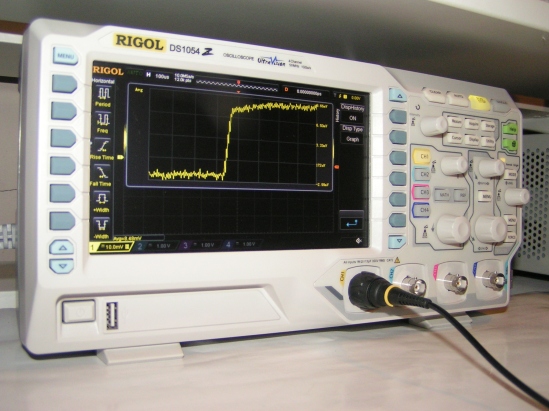Description
DS1054Z is a digital oscilloscope made by Rigol. This particular model is very popular now. It is so popular because it has tons of features and it is
- hackable:
This model was designed to be upgradable by buying unlocking codes from Rigol, without adding or modifying the oscilloscope’s hardware. Bandwidth upgrade from 50MHz to 100MHz, advanced triggers, memory depth, serial decoding protocols and so on, are all possible by simply typing a code on the oscilloscope’s screen. There is a free tool that can generate the upgrading codes: it’s called riglol. - built very well:
Rigol used to be a manufacturer for Agilent. Agilent was just re-branding the Rigol oscilloscopes and sell them as Agilent oscilloscopes. - cheap:
Only USD $400 for a 4 channels oscilloscope is affordable even for hobbyists and makers.
I am not affiliated or payed by Rigol in any way, just a happy DS1054Z owner.
Here is some less known info about DS1054Z
- Any DS1054Z can be turned into the highest model of the DS1000Z family, the DS1104Z. All you need to do is to simply type a code on the oscilloscope’s screen. The hardware for the DS1054Z, DS1074Z and DS1104Z is the same. DS1054Z is just a software limited version of a DS1104Z. DS1104Z is the top of the DS1000Z series, and is 2-5 times more expensive than a DS1054Z.
- Being LXI ready, the scope can be controlled by SCPI commands sent over LAN without installing any drivers on the PC side. No NI VISA, no IVI drivers and no Rigol drivers are required when controlling the oscilloscope over LAN.
- All you need when controlling the scope over LAN is simply a TCP socket using port 5555. You can even send SCPI commands manually, by using Telnet or NetCat. NetCat (AKA ‘nc’) is recommended, since Telnet protocol might filter out some characters, like i.e. chr(0). There is a NetCat version for Windows too.
- The SCPI programming manual for DS1000Z series scopes is incomplete. If you feel like some SCPI commands are missing, like e.g. MASK:DATA?, then check the programming manuals from the higher models (like DS2000 or even DS4000) in order to find out the correct syntax. Most of them will also work for DS1000Z series too.
- To check the firmware version normally, press UTILITY -> SYSTEM -> SYSTEM INFO in the “MENU” buttons group, but to check for more software details (undocumented):
Quickly press buttons MENU -> MENU -> FORCE -> MENU on “TRIGGER” buttons group, then go to info panel by pressing buttons UTILITY -> SYSTEM -> SYSTEM INFO in the “MENU” buttons group. - To find out the manufacturing date by serial number:
DS1ZA yy ww xxxxx
yy: 15=2013, 16=2014, 17=2015, 18=2016
ww: week number in indicated year - The latest firmware update can be downloaded without registration from:
http://beyondmeasure.rigoltech.com/acton/fs/blocks/showLandingPage/a/1579/p/p-0019/t/page/fm/0
or from http://int.rigol.com/Support/SoftDownload/3
Acronyms
MHz – Megahertz
PC – Personal Computer
LXI – LAN Extensions for Instrumentation
SCPI – Standard Commands for Programmable Instruments
LAN – Local Area Network
NI – National Instruments, http://www.ni.com
VISA – Virtual Instrument Software Architecture
IVI – Interchangeable Virtual Instrument
TCP – Transmission Control Protocol
AKA – Also Known As

Salut George !
Ai facut vreo verificare inainte si dupa upgrade pentru a vedea daca este reala cresterea benzii de frecventa ? Eu nu am o sursa de semnal profesionala , am folosit un generator software pentru raspberry pi , iar masuratorile nu arata o crestere corecta a valorilor masurate . Adica valorile de dupa 50 MHz scad dincolo de limita teoretica de 3 dB (aprox 30%), nu se mentin pana la 100 MHz .
MHz DCVrms50MHz DCVrms100MHz
0.125 2.35 2.32
0.15 2.35 2.33
1.00 2.35 2.34
10.00 2.39 2.40
25.00 2.44 2.52
50.00 2.56 2.83
75.00 2.16 2.45
100.00 1.62 1.69
Daca ai posibilitatea , poti verifica si tu ?
Multumesc !
LikeLiked by 1 person
What Robert says in another language sound very interesting, can it please be translated into English ?
LikeLike
Translation:
Hello George!
Did you check before and after the upgrade to see if the frequency band is actually increasing? I do not have a professional signal source, I used a Raspberry Pi software generator and the measurements do not show a correct increase in the measured values. That means the values after 50MHz drop below the theoretical limit of 3dB (about 30%), do not hold up to 100MHz.
MHz DCVRMS (50MHz) DCVRMS (100MHz)
0.125 2.35 2.32
0.15 2.35 2.33
1.00 2.35 2.34
10.00 2.39 2.40
25.00 2.44 2.52
50.00 2.56 2.83
75.00 2.16 2.45
100.00 1.62 1.69
If you can, can you check it out?
Thank you!
LikeLike